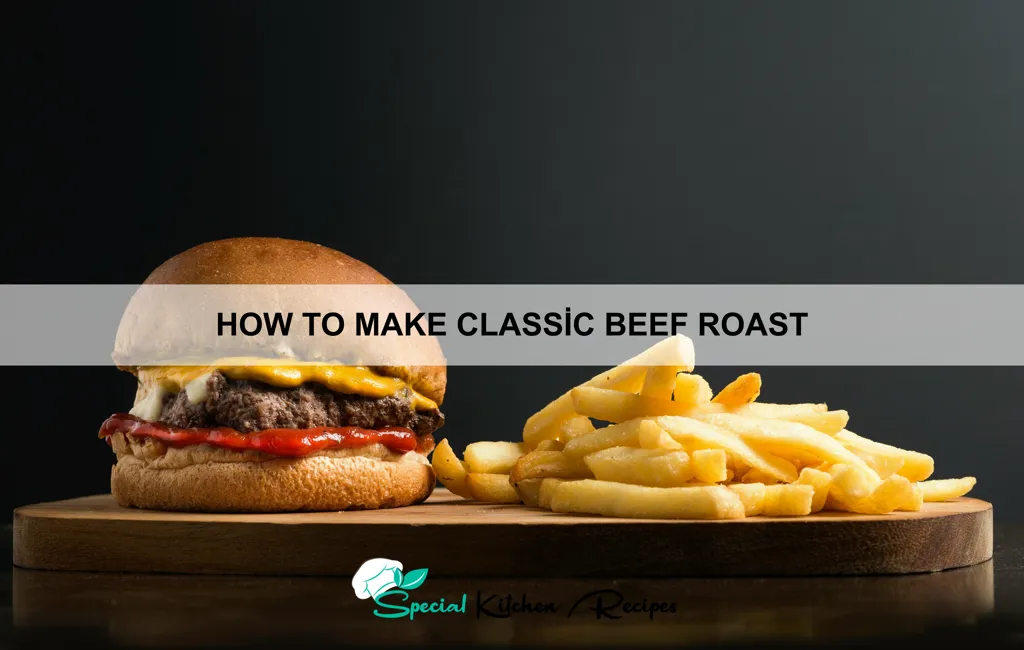The humble beef roast, a seemingly simple dish, boasts a rich and surprisingly complex history, interwoven with the development of human civilization itself. Its origins are lost in the mists of time, predating written records, but we can trace its evolution through various culinary traditions. Early forms likely involved roasting over open fires, a method used for millennia to cook large cuts of meat. The domestication of cattle, estimated to have begun around 10,500 years ago, provided the foundation for this culinary staple. Different cultures developed their own unique approaches; think of the slow-cooked roasts of medieval Europe, often served as a centerpiece of celebratory feasts, or the elaborate preparations found in various regional cuisines around the world.
The rise of the modern beef roast is closely tied to the agricultural revolutions and advancements in meat processing. The invention of the oven, and later, refrigeration, revolutionized how beef was cooked and stored. This allowed for more precise temperature control and longer cooking times, resulting in more tender and flavorful roasts. In the 19th and 20th centuries, the beef roast became a symbol of prosperity and family gatherings in many Western cultures. The iconic Sunday roast, a tradition in many English-speaking countries, solidifies its place in popular culture. While exact statistics on global beef consumption are difficult to pinpoint due to variations in reporting, it’s safe to say that beef roasts, in various forms, remain a cherished dish worldwide.
Beyond its culinary significance, the beef roast holds cultural weight as a symbol of abundance and hospitality. Sharing a roast often represents communal bonding and celebration. From holiday dinners to family reunions, the act of preparing and consuming a roast frequently signifies a special occasion. Its versatility is also key; different cuts of beef, marinades, and seasonings allow for endless variations, reflecting the diverse tastes and traditions of various regions. Today, while concerns about sustainability and ethical meat production are increasingly important, the classic beef roast continues to hold a firm place in our culinary landscape, a testament to its enduring appeal and significant cultural impact.
Ingredients and Measurements
The success of a classic beef roast hinges on selecting high-quality ingredients and using precise measurements. This recipe uses a 3-4 pound chuck roast, known for its rich flavor and tenderness when slow-cooked. Adjust quantities proportionally for larger or smaller roasts.
Beef Roast: 3-4 pounds boneless chuck roast. Choosing the right cut is crucial. Chuck roast, with its marbling and connective tissue, becomes incredibly tender when slow-cooked. Avoid leaner cuts as they can become dry.
Olive Oil: 2 tablespoons. Use a high-quality extra virgin olive oil for the best flavor. Don’t skimp on the oil; it’s essential for browning the roast and developing a flavorful crust.
Salt: 2 teaspoons kosher salt. Kosher salt is preferred for its larger crystals and even distribution. Generously season the roast; the salt penetrates the meat, enhancing its flavor. If using table salt, reduce the amount to approximately 1 teaspoon.
Black Pepper: 1 teaspoon freshly ground black pepper. Freshly ground black pepper offers a superior aroma and taste compared to pre-ground pepper. Don’t be shy with the pepper – it complements the beef beautifully.
Onion: 1 large yellow onion, chopped. The onion adds sweetness and depth to the roast’s flavor. Use a sharp knife to finely chop the onion for even cooking.
Garlic: 4 cloves garlic, minced. Freshly minced garlic provides a much more potent flavor than pre-minced garlic. Mince the garlic finely to ensure it disperses evenly throughout the roast.
Beef Broth: 1 ½ cups low-sodium beef broth. Low-sodium broth allows you to control the salt level in the final dish. Using broth instead of water adds another layer of flavor to the roast.
Carrots: 2 large carrots, peeled and chopped. Carrots add sweetness and vibrant color to the finished dish. Chop the carrots into roughly 1-inch pieces for even cooking.
Celery: 2 stalks celery, chopped. Celery contributes a slightly bitter and earthy note that balances the sweetness of the carrots and onions. Chop the celery similarly to the carrots for consistent cooking.
Bay Leaves: 2 bay leaves. Bay leaves impart a subtle, earthy, and slightly minty flavor. Remember to remove the bay leaves before serving, as they can be tough and unpleasant to eat.
Optional additions: Consider adding 1 teaspoon of dried thyme or rosemary for additional depth of flavor. You can also include a splash of red wine (about ½ cup) for richer taste.
Preparation of the Beef Roast
Choosing the right beef roast is paramount to a successful outcome. For a classic beef roast, aim for a 3-4 pound boneless chuck roast, or a similar cut known for its rich flavor and ability to become incredibly tender with slow cooking. Avoid overly lean cuts, as they can dry out during the cooking process. Look for marbling – the flecks of fat throughout the meat – which contributes significantly to flavor and juiciness.
Once you’ve selected your roast, remove it from its packaging and pat it completely dry with paper towels. This step is crucial for achieving a good sear, which will help develop a flavorful crust. Thoroughly drying the surface prevents steaming during browning, allowing for proper Maillard reaction.
Next, generously season the roast. For a classic flavor profile, use about 2 tablespoons of kosher salt and 1 tablespoon of freshly ground black pepper. Don’t be shy with the salt! It’s essential for seasoning the meat throughout. You can also add other seasonings at this stage, such as garlic powder, onion powder, paprika, or a blend of your favorite herbs. Rub the seasoning mixture all over the roast, ensuring it’s evenly distributed.
At this point, you can optionally sear the roast. This step is highly recommended as it adds depth of flavor and a beautiful crust. Heat 2 tablespoons of high-smoke-point oil (such as canola or vegetable oil) in a large oven-safe skillet or Dutch oven over medium-high heat. Once the oil is hot, carefully place the roast in the skillet and sear on all sides, about 2-3 minutes per side, until a nice brown crust forms. Avoid overcrowding the pan; if necessary, sear the roast in batches.
After searing (if you choose to do so), you’re ready to proceed with the chosen cooking method – whether it’s roasting in the oven, slow cooking in a crockpot, or braising on the stovetop. Remember to adjust cooking times based on the weight of your roast and your preferred level of doneness. A meat thermometer is your best friend for ensuring the roast reaches the desired internal temperature.
Searing the Beef Roast
Searing your beef roast is a crucial step in achieving a delicious, flavorful, and beautifully browned result. It creates a flavorful crust while simultaneously locking in the juices, leading to a more tender and juicy final product. Before you begin, ensure your beef roast is completely patted dry with paper towels. This is essential for proper browning; moisture will prevent the Maillard reaction, which is responsible for that desirable crust.
For a 3-4 pound beef roast (such as a chuck roast or bottom round), you’ll need approximately 2 tablespoons of high-smoke-point oil, such as canola, grapeseed, or avocado oil. Avoid olive oil, as its lower smoke point can lead to burning and an unpleasant taste. Heat the oil in a heavy-bottomed Dutch oven or large oven-safe skillet over high heat. The pan should be screaming hot before you add the roast; a drop of water should instantly evaporate.
Generously season the roast with salt and freshly ground black pepper. Don’t be shy! A good crust relies on seasoning. You can also add other spices at this stage, such as garlic powder, onion powder, or paprika, to enhance the flavor profile. Once the oil is shimmering and hot, carefully place the roast into the pan. Avoid overcrowding the pan; if necessary, sear the roast in batches.
Sear the roast for 3-4 minutes per side, undisturbed, until a deep brown crust forms. Resist the urge to move it around too much; this will prevent proper browning. Use tongs to gently rotate the roast, ensuring all sides are seared evenly. For larger roasts, you may need to sear the sides and ends as well. The goal is a rich, dark brown color indicating a perfect Maillard reaction.
Important Note: Do not salt the roast too far in advance, as this can draw out moisture and hinder browning. Season generously just before searing. Once seared, you can proceed with the next steps of your recipe, such as browning aromatics in the same pan or transferring the roast to a roasting pan for further cooking in the oven. The seared crust will add immense depth of flavor to your finished beef roast.
After searing, you’ll notice a delicious fond (browned bits) at the bottom of the pan. Do not discard this! It’s packed with flavor and will be used to create a rich and flavorful pan sauce later on. This will elevate your beef roast to the next level.
Roasting the Beef Roast
Once your beef roast is prepped (trimmed, seasoned, and possibly seared), it’s time to roast it to perfection. The key to a juicy, flavorful roast is understanding temperature and time. We’ll be focusing on a 3-4 pound chuck roast, but adjustments can be made for larger or smaller cuts.
Preheat your oven to 325°F (160°C). This lower temperature ensures even cooking and prevents the outside from burning before the inside is cooked through. Avoid high heat, as this will lead to a tough, dry roast.
Place the seasoned roast in a roasting pan. If you prefer a richer flavor, you can add about 1 cup of beef broth or red wine to the bottom of the pan. This will create a flavorful base for your pan juices later. Don’t add too much liquid, as this can steam the roast instead of roasting it.
Roast the beef for approximately 20-25 minutes per pound for medium-rare. For medium, aim for 25-30 minutes per pound, and for well-done, plan on 30-35 minutes per pound. These are estimates; using a meat thermometer is crucial for accuracy.
A meat thermometer inserted into the thickest part of the roast should register the following internal temperatures:
- Rare: 125-130°F (52-54°C)
- Medium-Rare: 130-140°F (54-60°C)
- Medium: 140-150°F (60-66°C)
- Medium-Well: 150-160°F (66-71°C)
- Well-Done: 160°F+ (71°C+)
Remember to let the roast rest for at least 15-20 minutes before carving. This allows the juices to redistribute throughout the meat, resulting in a more tender and flavorful roast. Tent the roast loosely with foil to keep it warm during resting.
While the roast rests, you can make a delicious gravy from the pan juices. Simply strain the juices, skim off excess fat, and bring to a simmer on the stovetop. Thicken with a cornstarch slurry (1 tablespoon cornstarch mixed with 2 tablespoons cold water) if desired.
Enjoy your perfectly roasted beef roast! Remember that practice makes perfect. Don’t be discouraged if your first attempt isn’t flawless; each roast will teach you something new.
Making the Gravy (Optional)
While a perfectly roasted beef is delicious on its own, a rich and flavorful gravy elevates the entire meal. This section details how to make a classic gravy using the pan drippings from your roast. Don’t discard those drippings! They contain the essence of flavor from the roasting process.
First, carefully remove the roast from the roasting pan and set it aside to rest. Place the roasting pan on the stovetop over medium heat. If there are large chunks of fat congealed on top, carefully spoon them out, leaving behind the flavorful browned bits (fond) stuck to the bottom of the pan. These browned bits are crucial for a deeply flavorful gravy.
Add approximately 1/4 cup of all-purpose flour to the pan and whisk constantly for 1-2 minutes. This process, called a roux, will help thicken the gravy. Ensure the flour is fully incorporated and toasted lightly to a golden color; avoid burning it, as this will impart a bitter taste. Gradually whisk in 2 cups of beef broth (or a combination of beef broth and red wine for a richer flavor), stirring continuously to prevent lumps. Continue whisking until the gravy begins to thicken.
Bring the gravy to a gentle simmer, reduce the heat to low, and continue to simmer for 5-7 minutes, stirring occasionally, allowing the flavors to meld. Taste the gravy and season accordingly. You may need to add salt, freshly ground black pepper, and perhaps a pinch of garlic powder or onion powder to enhance the flavor profile. If the gravy is too thick, add a little more broth; if it’s too thin, simmer it uncovered for a few more minutes to reduce the liquid.
For a smoother gravy, strain it through a fine-mesh sieve before serving. This removes any lumps or browned bits that may have survived the initial whisking. Strain the gravy directly into a gravy boat or serving dish. You can garnish the gravy with a sprig of fresh parsley or a few drops of good quality olive oil for an extra touch of elegance. Serve immediately alongside your perfectly roasted beef.
Important Note: If you prefer a less rich gravy, you can reduce the amount of fat you leave in the pan before adding the flour. Alternatively, you can skim off excess fat from the finished gravy once it has cooled slightly. Experiment with different flavor combinations to create your perfect gravy.
Resting the Beef Roast
Resting your beef roast is arguably the most crucial step in achieving a tender, juicy, and flavorful final product. It’s tempting to carve into that beautiful roast immediately after removing it from the oven, but patience is key. During the resting period, the muscle fibers relax, allowing the juices to redistribute throughout the meat. Cutting into it too soon will result in a dry, disappointing roast.
How long should you rest your roast? This depends on the size of your roast. As a general guideline, allow for 15-20 minutes of resting time for every pound of beef. For example, a 3-pound roast should rest for at least 45-60 minutes. Larger roasts (over 5 pounds) may benefit from even longer resting times, up to 90 minutes or more. Use a meat thermometer to ensure the roast has reached the desired internal temperature before removing it from the oven; this is your starting point for calculating resting time.
Where should you rest your roast? The ideal resting environment is a warm, dry place. Avoid placing the roast directly on a cold surface, as this will rapidly cool the meat and halt the redistribution of juices. A great option is to loosely tent the roast with aluminum foil. This helps to retain heat while still allowing some moisture to escape. Alternatively, you can transfer the roast to a clean, warm roasting pan and cover it loosely with foil. Do not wrap the roast tightly in foil or plastic wrap, as this will trap steam and make the roast soggy.
Why is resting so important? During cooking, the muscle fibers contract, squeezing out the juices. Resting allows these fibers to relax, drawing the juices back into the meat. This results in a significantly more tender and juicy roast. Ignoring the resting period is a common mistake that can dramatically affect the quality of your final dish.
What to do while the roast rests: Use the resting time wisely! Prepare your serving platter, make any accompanying sauces or gravy, and allow yourself a moment to relax before carving and enjoying your delicious, perfectly rested beef roast. Remember, a little patience goes a long way in achieving culinary excellence.
Important Note: The internal temperature of the roast will continue to rise slightly during the resting period. This is perfectly normal and contributes to even cooking.
Recommendations
For the best results when making a classic beef roast, remember to always use a meat thermometer to ensure the beef reaches your desired level of doneness. Avoid overcooking, as this will result in a dry and tough roast. Aim for a temperature between 130°F (54°C) for rare, 140°F (60°C) for medium-rare, and 160°F (71°C) for medium-well. Let the roast rest for at least 15-20 minutes after cooking before carving to allow the juices to redistribute, resulting in a more tender and flavorful final product.
Serving suggestions abound! A classic beef roast pairs beautifully with creamy mashed potatoes, roasted root vegetables like carrots and parsnips, and a rich gravy made from the pan drippings. Consider adding a vibrant green vegetable, such as asparagus or green beans, to balance the richness of the dish. For a festive touch, serve with Yorkshire puddings or horseradish cream.
Storage: Leftover roast beef should be stored in an airtight container in the refrigerator for up to 3-4 days. You can also freeze leftover roast beef for up to 3 months. To freeze, wrap the beef tightly in plastic wrap and then aluminum foil, or use a freezer-safe bag. Reheat gently in the oven or microwave.
Complementary Dishes: To enhance your beef roast experience, consider these pairings: a robust red wine like Cabernet Sauvignon or Merlot, a tangy cranberry sauce, or a simple salad with a vinaigrette dressing. These additions provide contrasting flavors and textures that complement the richness of the beef.
Nutritional Information (per 100g serving, approximate values will vary based on cut and preparation): Calories: Approximately 250-350; Protein: 25-30g; Fat: 15-25g; Carbohydrates: 0-5g. Note: This information is an estimate and can vary significantly depending on the cut of beef, cooking method, and any added ingredients like gravy or sauces. For precise nutritional information, consult a nutrition calculator or professional.
Important Note: Always handle raw beef with care to avoid cross-contamination. Wash your hands thoroughly after handling raw meat and ensure all cooking utensils are properly cleaned.





